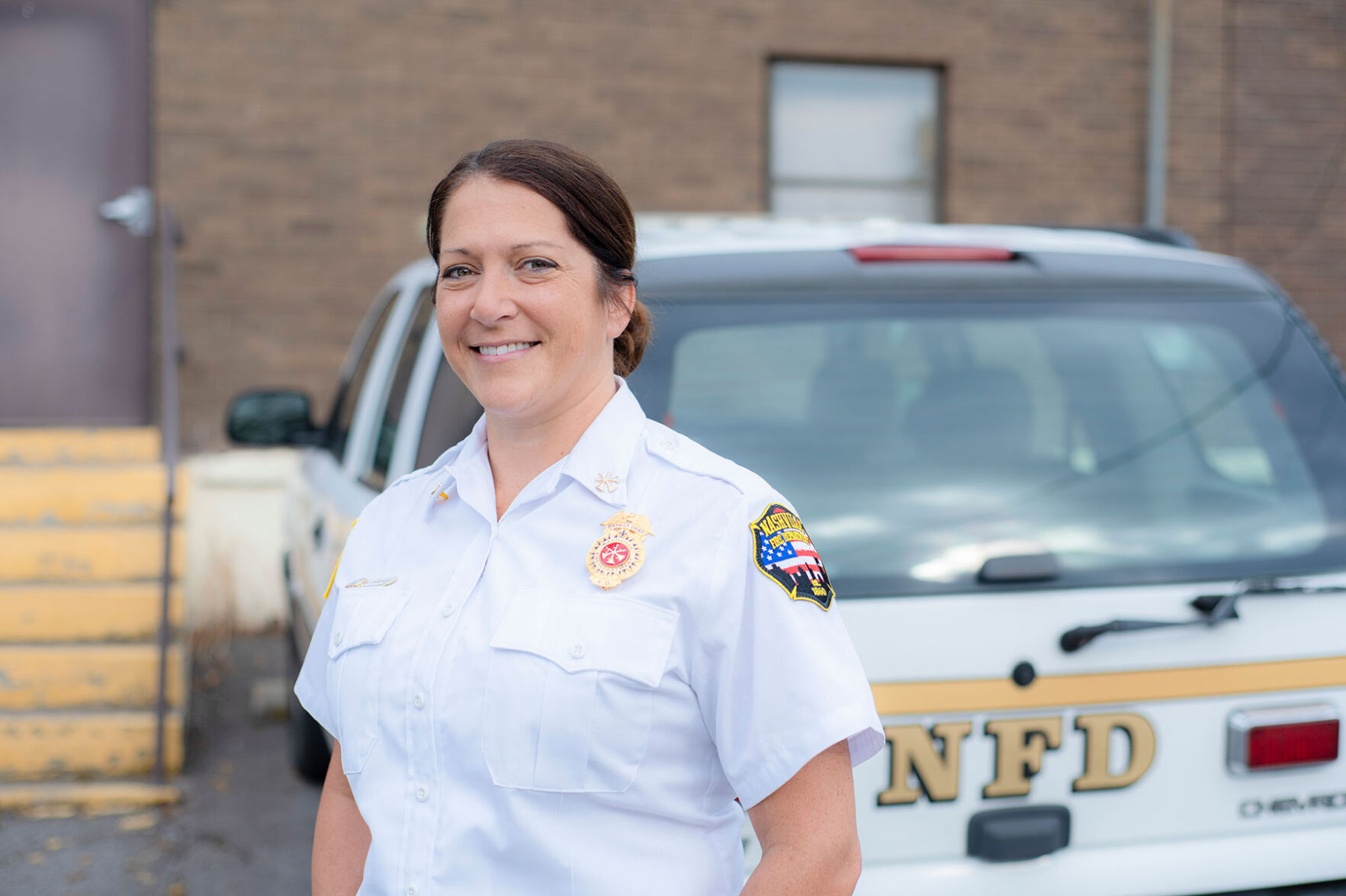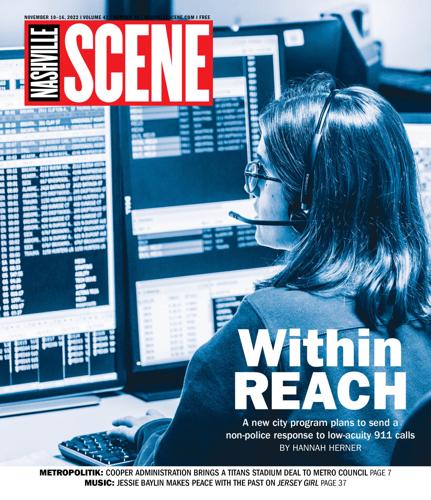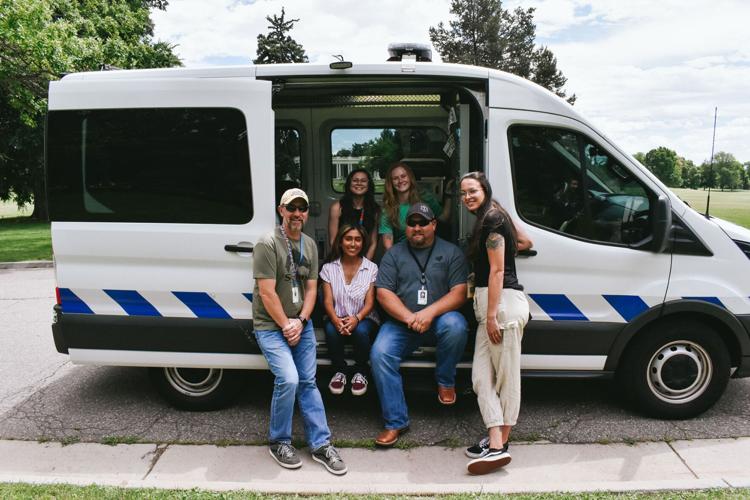If someone calls 911 in Nashville while experiencing a mental health crisis, the person who answers goes through a series of questions with them. If the caller is deemed nonviolent, the call information is sent over to a team of fire department dispatchers, which also houses emergency medical services. If there’s a threat, the call is sent to police dispatchers.
In the former, an ambulance heads to the scene. It’s not uncommon for emergency staff to already know the person experiencing the crisis — they’re often someone who needs ongoing mental health support and relies on emergency services to fill that void. As of right now, the fire department staff has only one option: to take that person to the emergency room.
But soon that will change. The pilot program for REACH (Responders Engaged and Committed to Help), set to launch Feb. 1, will team a paramedic from the Nashville Fire Department with a master’s-level clinician from Nashville’s Mental Health Cooperative. The pair will arrive at the scene in an SUV. The program is an effort to better address behavioral health incident calls that have the city’s ambulances taking more than 120 people to the emergency room each week.
Heading up the program are Brooke Haas, EMS special operations chief with the Nashville Fire Department, and Stephen Martini, director at the Metro Nashville Department of Emergency Communications. Haas describes two primary goals for the program: get the person having a mental health crisis where they need to be, and cut down on unnecessary ambulance transports.
Where an ambulance has just one option of where to take a patient, REACH will have a lot more freedom to transport people to community resources — including places like the Mental Health Coop, Centerstone, Park Center, Neighborhood Health and even the caller’s own home.
“Really, their options are hospital, or we don’t transport,” says Martini. “Police officers are very similar. They take you to jail or they don’t take you anywhere. We don’t want a taxi service, but we’re in a moment that says if you call 911 and your problem can’t be solved by taking someone to jail or transporting someone to the hospital, [there aren’t other options]. … We needed a new solution.”

Brooke Haas, EMS special operations chief with the Nashville Fire Department
There are just 28 ambulances in Davidson County. If one is tied up on a call where they’re not really needed, Haas explains, it extends the response time for another, possibly more acute medical situation. Unlike police, the fire department is not tied to a police precinct. Instead, each call is assigned to the nearest ambulance. During its pilot program, REACH is set to run from noon until 10 p.m., Tuesday through Saturday. The two cars will often have overlapping shifts, but because the program is launching with just four total staff, sometimes there will be only one car on duty.
REACH shouldn’t be confused with the city’s other co-response program, Partners in Care, which was introduced in late 2021. Partners in Care pairs a mental health clinician with a police officer. “Acuity” is a keyword that differentiates the two programs: Partners in Care is high-acuity, meaning the person in question is often actively suicidal or experiencing psychosis, and may even need involuntary committal to the hospital; REACH, on the other hand, will be responding to lower-acuity mental health calls.
The Metro Council voted in September 2022 to expand Partners in Care. Starting Nov. 1, the program opened up in the South Precinct, putting it in four out of the city’s eight total precincts.
In the most recent quarter, Partners in Care responded to 300 calls. Of those, 14 people were arrested. Overall, around 5 percent of the people involved went to jail, and around 5 percent of calls resulted in use of force. Roughly 15 percent of dispatches were by request of an officer, but most of the calls came directly through 911 or the non-emergency line. In Partners in Care calls, people were most commonly transported to the emergency room (34.2 percent), while 32 percent went to a different community service and 11.6 percent were transported to inpatient mental health treatment. Another 5 percent were taken to the Comprehensive Treatment Center for opioid use disorder.
Michael Randolph, program manager for Partners in Care on the Mental Health Coop side, will also lead the REACH team. Nationally, he says, there’s a lack of inpatient and outpatient services specifically for mental health, so the burden has been falling on first responders. He hopes to take some of that burden back.
“What’s happened is, who started dealing with a lot more mental health is firefighters, EMTs, police officers and emergency rooms,” Randolph says. “Hopefully, as mental health leans into working with these responders to become more of a first responder like them to better respond to these calls, we can take some of the [burden] off the system.”
Under the umbrella of emergency psychiatric services, Mental Health Coop’s Crisis Stabilization Unit has 15 beds; the Crisis Treatment Center has 12 observation beds; and the Intensive Intervention Center has eight beds. That’s a total of 35 beds. Randolph anticipates that while REACH will bring a lot of referrals to these beds, not all will need this level of care, and REACH will refer to other inpatient and outpatient services based on need.
“We can go to Mental Health Coop, but at some point, they will be full,” Haas adds. ”We’re going to keep looking at that to make sure that we have a good, solid — eventually — list of options for different places that we can take people and make sure the infrastructure is there to support that.”
Another issue REACH could run into is not having enough staff to support eventual expansion of the program. According to Robert McAlister, the NFD’s EMS director, the city is already having trouble finding 36 EMTs to staff three new ambulances by the end of the year. Paramedics are even tougher to come by, as they have an even higher level of education.
There’s a scarcity in mental health professionals post-COVID too, Randolph adds.
“We’re all a little burned out,” Randolph says. “But hopefully this is a relief. If we’re assessing and responding to crises more efficiently and effectively, it gives some relief to the emergency rooms, the fire department, the police department and other crisis factors.”
Both sides will participate in cross-training: Paramedics will receive the 40-hour crisis intervention training that Mental Health Coop offers; on the flip side, mental health clinicians will learn CPR and first aid. At least for now, REACH leaders are holding steadfast when it comes to keeping the qualifications high, though Randolph and Haas agree that in the future the program could expand to include more levels of responders.
Sending the highest level of paramedic along with a mental health clinician ensures that response time is shorter, as they don’t have to consult their supervisors. Before this program, EMTs and paramedics without a background in mental health response were often left to make the call for a patient in crisis with help from supervisors and sometimes the Mental Health Coop’s mobile crisis vehicle.
“Right now, if we are dispatched to a person having suicidal thoughts, we will transport them to the hospital,” Haas says. “If they don’t want to go to the hospital, it becomes a little bit more involved. Because we can’t leave them. We don’t know how to make those determinations from the mental, behavioral health side of things, whether they can stay or go. So when that happens, that’s when we get more people involved.”

Members of Denver's STAR program
Nashville’s spectrum of policing programs is modeled after that of Denver. That city introduced a co-response model with police similar to Partners in Care in 2016 called Crisis Intervention Response Unit, and a co-response model outside of police in June 2020. Earlier this year, Denver put up $1.4 million to expand this non-police response, called STAR (Support Team Assisted Response).
STAR gets a lot of calls from other cities looking to replicate the program, says STAR spokesperson Emily Williams. Since it began, the program responded to more than 2,700 calls, though there were more than 11,000 that would have qualified. Evan Thompkins, STAR program specialist, points out that even a police co-response program can still exacerbate mental health issues.
“Interacting with a police officer if you’re already in mental health distress, a lot of times that can elevate people, especially if they’ve already had bad experiences with the police,” Thompkins says. “Sometimes if a police officer shows up, they might just see something not as mental health, and maybe they arrest the person or that person gets a ticket. That just compounds the problem. That person doesn’t get the care that they actually need.”
One pitfall with the STAR program is that 30 percent of their calls have first been responded to by police. Even so, for those where STAR responded first, none of them required police backup.
“We’re working on that data to see how we can minimize that percentage so that STAR is always the first correct response,” Williams says. “But I think what it shows is that Denver is really working to make sure people get the right response at the right time, and when a police officer shows up and says they are not the right person, they’ve got another team that they can call.”
Unlike with Nashville’s program, STAR partners with the city’s safety-net hospital to provide EMT to staff its vehicles. This year, they’ve also asked for funding to help recruit and train more behavioral health professionals to mitigate the shortage. STAR is also introducing further wraparound services, as roughly two-thirds of the people they respond to are experiencing homelessness.
“One of the lessons learned that Denver had is when they focused a non-law-enforcement mental health care response in their downtown district, they wound up really running unintentionally a homeless impact response,” Martini says.
In February 2021, before Partners in Care was introduced, Nashville Organized for Action and Hope started working on a plan for an emergency response program called HEALS (Health Engagement and Liaison Services). This program closely resembles CAHOOTS (Crisis Assistance Helping Out On The Streets) a Eugene, Ore., program that’s been active for nearly 30 years and on which STAR based its model. A key difference in NOAH’s design would be replacing the master’s-level mental health counselors with lower-level mental health clinicians, or EMTs with lived experience of mental illness and/or homelessness.
Jane Boram, co-chair for NOAH’s criminal justice task force, expresses concern that there weren’t enough community stakeholders involved in the decision to start the REACH pilot. Of the 27 groups invited to collaborate, says Boram, many outside of Metro didn’t show or didn’t receive information on the meetings in a timely manner. Nashville was one of seven sites to receive specialized technical assistance and strategic planning earlier this year from the USDA Substance Abuse and Mental Health Administration’s GAINS Center for Behavioral Health and Justice Transformation. That collaboration started in April, and by September, Martini and Haas presented the program to the Metro Behavioral Health and Wellness Advisory Council, where it was approved.
“The concern is that we did not have any kind of community engagement,” Boram says. “Nobody offered up any ideas about, ‘Is this a good idea? Is this not a good idea? Do people in North Nashville want this? What’s the Black community saying? The Hispanic community saying? What’s the LGBTQ community saying?’ There’s just no diversity.”
In response, TJ Ducklo, spokesperson and adviser for Mayor John Cooper, points to the success of Partners in Care and promises collaboration with NOAH and other community partners.
“Earlier this year, in recognition of our good work, Metro got the opportunity to partner with federal experts to develop a non-law-enforcement pilot,” Ducklo tells the Scene. “A stakeholder group with representatives of 27 departments, advocacy groups and nonprofits contributed to the design of a pilot program that will pair mental health professionals with paramedic captains to respond to people in crisis without putting them in dangerous environments. The leadership for this pilot program has also briefed the Behavioral Health and Wellness Advisory Council on this process. Planning and collaboration with community partners will continue and will include direct conversations with NOAH and others, as Mayor Cooper has committed to.”
The Metro Council has approved $273,000 in general services district funding to provide two vehicles and two paramedics for REACH in the FY23 budget. This funding is meant to last through June 2023, and new funding will need to be approved by the council in the FY24 budget process. The funding for the mental health clinicians has yet to be secured.
The Metro Nashville Police Department is also on board with REACH.
Anthony Brooks, lieutenant of alternative policing strategies, says since he started at MNPD, he has noticed more mental health issues in the field. He’s not sure if it’s getting worse, or if officers are more aware of it now thanks to training related to the Partners in Care program. It’s probably a bit of both, he says.
“The REACH program that’s being planned plus Partners in Care, I think they’re going to work alongside each other as a community and really do some good,” Brooks says.
In the future, Randolph hopes to partner with additional organizations to offer more services — such as providing housing and food in a time of crisis.
Says Randolph, “If we look five years down the line of what kind of crisis response we need in Nashville, we wanted to have everything throughout the spectrum to meet people where they’re at in a crisis and give them the correct help in a trauma-informed way, and do things as therapeutic as possibly and give them as much choice and as much empowerment in that crisis as we can.”
According to Haas, at the outset, REACH’s goal is to determine a new way to help the 120-plus patients per week who are currently being taken to the hospital.
“Once we get a handle on that, to see what’s working and not working, there’s different levels of care — including peer support, follow-ups, checking on people, things like that — that we would love to be able to do in the future that would bring in other agencies,” Haas says. “But for this pilot, we’re gonna stick with the fire department and the Mental Health Coop.”
The emergency room often isn’t the best place for someone experiencing a mental health crisis. Ultimately — for REACH, for community advocates, for stakeholders — the hope is that when calling 911, people experiencing such crises will have another option.






